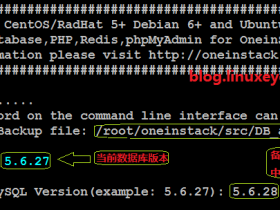一、MySQL 获得当前日期时间函数
1.1 获得当前日期+时间(date + time)函数:now()
mysql> select now(); +———————+ | now() | +———————+ | 2013-02-26 10:28:16 | +———————+
除了now() 函数能获得当前的日期时间外,MySQL 中还有下面的函数:
mysql> select current_timestamp(); +———————+ | current_timestamp() | +———————+ | 2013-02-26 10:29:36 | +———————+ mysql> select current_timestamp; +———————+ | current_timestamp | +———————+ | 2013-02-26 10:29:43 | +———————+ mysql> select localtime(); +———————+ | localtime() | +———————+ | 2013-02-26 10:29:53 | +———————+ mysql> select localtime; +———————+ | localtime | +———————+ | 2013-02-26 10:29:59 | +———————+ mysql> select localtimestamp(); +———————+ | localtimestamp | +———————+ | 2013-02-26 10:30:11 | +———————+ mysql> select localtimestamp; +———————+ | localtimestamp() | +———————+ | 2013-02-26 10:30:17 | +———————+
这些日期时间函数,都等同于 now()。鉴于 now() 函数简短易记,建议总是使用 now() 来替代上面列出的函数。
1.2 获得当前日期+时间(date + time)函数:sysdate()
sysdate() 日期时间函数跟 now() 类似,不同之处在于:now() 在执行开始时值就得到了, sysdate() 在函数执行时动态得到值。看下面的例子就明白了:
mysql> select now(), sleep(3), now(); +———————+———-+———————+ | now() | sleep(3) | now() | +———————+———-+———————+ | 2013-02-26 10:33:10 | 0 | 2013-02-26 10:33:10 | +———————+———-+———————+ mysql> select sysdate(), sleep(3), sysdate(); +———————+———-+———————+ | sysdate() | sleep(3) | sysdate() | +———————+———-+———————+ | 2013-02-26 10:33:23 | 0 | 2013-02-26 10:33:26 | +———————+———-+———————+
可以看到,虽然中途 sleep 3 秒,但 now() 函数两次的时间值是相同的; sysdate() 函数两次得到的时间值相差 3
秒。MySQL Manual 中是这样描述 sysdate() 的:Return the time at which the function
executes。
sysdate() 日期时间函数,一般情况下很少用到。
1.3 获得当前日期(date)函数:curdate()
mysql> select curdate(); +————+ | curdate() | +————+ | 2013-02-26 | +————+
其中,下面的两个日期函数等同于 curdate():
mysql> select current_date(); +—————-+ | current_date() | +—————-+ | 2013-02-26 | +—————-+ mysql> select current_date; +————–+ | current_date | +————–+ | 2013-02-26 | +————–+
1.4 获得当前时间(time)函数:curtime()
mysql> select curtime(); +———–+ | curtime() | +———–+ | 10:36:31 | +———–+
其中,下面的两个时间函数等同于 curtime():
mysql> select current_time(); +—————-+ | current_time() | +—————-+ | 10:36:40 | +—————-+
mysql> select current_time; +————–+ | current_time | +————–+ | 10:36:44 | +————–+
1.5 获得当前 UTC 日期时间函数:utc_date(), utc_time(), utc_timestamp()
mysql> select utc_timestamp(), utc_date(), utc_time(), now(); +———————+————+————+———————+ | utc_timestamp() | utc_date() | utc_time() | now() | +———————+————+————+———————+ | 2013-02-26 02:42:34 | 2013-02-26 | 02:42:34 | 2013-02-26 10:42:34 | +———————+————+————+———————+
因为我国位于东八时区,所以本地时间=UTC时间+8小时。UTC时间在业务涉及多个国家和地区的时候,非常有用。
二、MySQL日期时间Extract(选取)函数。
1. 选取日期时间的各个部分:日期、时间、年、季度、月、日、小时、分钟、秒、微秒
mysql> set @dt=’2013-02-26 11:42:09.123456′; mysql> select date(@dt); — 2013-02-26 mysql> select time(@dt); — 11:42:09.123456 mysql> select year(@dt); — 2013 mysql> select quarter(@dt); — 1 mysql> select month(@dt); — 2 mysql> select week(@dt); — 8 mysql> select day(@dt); — 26 mysql> select hour(@dt); — 11 mysql> select minute(@dt); — 42 mysql> select second(@dt); — 9 mysql> select microsecond(@dt); — 123456
2. MySQL Extract() 函数,可以上面实现类似的功能:
mysql> set @dt=’2013-02-26 11:42:09.123456′; mysql> select extract(year from @dt); — 2013 mysql> select extract(quarter from @dt); — 1 mysql> select extract(month from @dt); — 2 mysql> select extract(week from @dt); — 8 mysql> select extract(day from @dt); — 26 mysql> select extract(hour from @dt); — 11 mysql> select extract(minute from @dt); — 42 mysql> select extract(second from @dt); — 9 mysql> select extract(microsecond from @dt); — 123456 mysql> select extract(year_month from @dt); — 201302 mysql> select extract(day_hour from @dt); — 2611 mysql> select extract(day_minute from @dt); — 261142 mysql> select extract(day_second from @dt); — 26114209 mysql> select extract(day_microsecond from @dt); — 26114209123456 mysql> select extract(hour_minute from @dt); — 1142 mysql> select extract(hour_second from @dt); — 114209 mysql> select extract(hour_microsecond from @dt); — 114209123456 mysql> select extract(minute_second from @dt); — 4209 mysql> select extract(minute_microsecond from @dt); — 4209123456 mysql> select extract(second_microsecond from @dt); — 9123456
MySQL Extract() 函数除了没有date(),time()
的功能外,其他功能一应具全。并且还具有选取‘day_microsecond’ 等功能。注意这里不是只选取 day 和
microsecond,而是从日期的 day 部分一直选取到 microsecond 部分。够强悍的吧!
MySQL Extract() 函数唯一不好的地方在于:你需要多敲几次键盘。
3. MySQL dayof… 函数:dayofweek(), dayofmonth(), dayofyear()
分别返回日期参数,在一周、一月、一年中的位置
mysql> set @dt=’2013-02-26′; mysql> select dayofweek(@dt); — 3 mysql> select dayofmonth(@dt); — 26 mysql> select dayofyear(@dt); — 57
日期 ’2013-02-26′ 是一周中的第 3 天(1 = Sunday, 2 = Monday, …, 7 = Saturday);一月中的第 26 天;一年中的第 57 天
4. MySQL week… 函数:week(), weekofyear(), dayofweek(), weekday(), yearweek()
mysql> select week(@dt); — 8 mysql> select week(@dt,3); — 9 mysql> select weekofyear(@dt); — 9 mysql> select dayofweek(@dt); — 3 mysql> select weekday(@dt); — 1 mysql> select yearweek(@dt); — 201308
MySQL week() 函数,可以有两个参数,具体可看手册。 weekofyear() 和 week() 一样,都是计算“某天”是位于一年中的第几周。 weekofyear(@dt) 等价于 week(@dt,3)。
MySQL weekday() 函数和 dayofweek() 类似,都是返回“某天”在一周中的位置。不同点在于参考的标准,
weekday:(0 = Monday, 1 = Tuesday, …, 6 = Sunday); dayofweek:(1 = Sunday,
2 = Monday, …, 7 = Saturday)
MySQL yearweek() 函数,返回 year(2008) + week 位置(31)。
5. MySQL返回星期和月份名称函数:dayname(), monthname()
mysql> set @dt=’2013-02-26′; mysql> select dayname(@dt); — Tuesday mysql> select monthname(@dt); — February
6. MySQL last_day() 函数:返回月份中的最后一天。
mysql> select last_day(’2013-02-26′); — 2013-02-28 mysql> select last_day(’2013-03-26′); — 2013-03-31
MySQL last_day() 函数非常有用,比如我想得到当前月份中有多少天,可以这样来计算:
mysql> select now(), day(last_day(now())) as days; +———————+——+ | now() | days | +———————+——+ | 2013-02-26 18:12:22 | 28 | +———————+——+
三、MySQL 日期时间计算函数
1. MySQL 为日期增加一个时间间隔:date_add()
mysql> set @dt=now(); mysql> select date_add(@dt, interval 1 day); — 2013-02-27 18:14:01 mysql> select date_add(@dt, interval 1 hour); — 2013-02-26 19:14:01 mysql> select date_add(@dt, interval 1 minute); — 2013-02-26 18:15:01 mysql> select date_add(@dt, interval 1 second); — 2013-02-26 18:14:02 mysql> select date_add(@dt, interval 1 microsecond); — 2013-02-26 18:14:01.000001 mysql> select date_add(@dt, interval 1 week); — 2013-03-05 18:14:01 mysql> select date_add(@dt, interval 1 month); — 2013-03-26 18:14:01 mysql> select date_add(@dt, interval 1 quarter); — 2013-05-26 18:14:01 mysql> select date_add(@dt, interval 1 year); — 2014-02-26 18:14:01 mysql> select date_add(@dt, interval -1 day); — 2013-02-25 18:14:01
MySQL adddate(), addtime()函数,可以用 date_add() 来替代。下面是 date_add() 实现 addtime() 功能示例:
mysql> select date_add(@dt, interval ’01:15:30′ hour_second); +————————————————+ | date_add(@dt, interval ’01:15:30′ hour_second) | +————————————————+ | 2013-02-26 19:29:31 | +————————————————+
mysql> select date_add(@dt, interval ’1 01:15:30′ day_second); +————————————————-+ | date_add(@dt, interval ’1 01:15:30′ day_second) | +————————————————-+ | 2013-02-27 19:29:31 | +————————————————-+
date_add() 函数,分别为 @dt 增加了“1小时 15分 30秒” 和 “1天 1小时 15分 30秒”。建议:总是使用 date_add() 日期时间函数来替代 adddate(), addtime()。
2. MySQL 为日期减去一个时间间隔:date_sub()
mysql> select date_sub(’2013-02-26 18:32:27′,interval ‘ 1 1:1:1′ day_second); +—————————————————————-+ | date_sub(’2013-02-26 18:32:27′,interval ‘ 1 1:1:1′ day_second) | +—————————————————————-+ | 2013-02-25 17:31:26 | +—————————————————————-+
MySQL date_sub() 日期时间函数 和 date_add() 用法一致,不再赘述。另外,MySQL 中还有两个函数 subdate(), subtime(),建议,用 date_sub() 来替代。
3. MySQL 另类日期函数:period_add(P,N), period_diff(P1,P2)
函数参数“P” 的格式为“YYYYMM” 或者 “YYMM”,第二个参数“N” 表示增加或减去 N month(月)。
MySQL period_add(P,N):日期加/减去N月。
mysql> select period_add(201302,2),period_add(201302,-2); +———————-+———————–+ | period_add(201302,2) | period_add(201302,-2) | +———————-+———————–+ | 201304 | 201212 | +———————-+———————–+
MySQL period_diff(P1,P2):日期 P1-P2,返回 N 个月。
mysql> select period_diff(201304,201302); +—————————-+ | period_diff(201304,201302) | +—————————-+ | 2 | +—————————-+
在 MySQL 中,这两个日期函数,一般情况下很少用到。
4. MySQL 日期、时间相减函数:datediff(date1,date2), timediff(time1,time2)
MySQL datediff(date1,date2):两个日期相减 date1 – date2,返回天数。
select datediff(’2013-04-27′,’2013-02-28′); — 58 select datediff(now(),’2013-02-06 15:00:00′); — 22
注意:timediff(time1,time2) 函数的两个参数类型必须相同。
四、MySQL 日期转换函数、时间转换函数
1. MySQL (时间、秒)转换函数:time_to_sec(time), sec_to_time(seconds)
select time_to_sec(’01:00:05′); — 3605 select sec_to_time(3605); — ’01:00:05′
2. MySQL (日期、天数)转换函数:to_days(date), from_days(days)
select to_days(’2013-02-28′); — 735292 ##从公元0年算 select from_days(735291); — 2013-02-27
3. MySQL Str to Date (字符串转换为日期)函数:str_to_date(str, format)
select str_to_date(’02.28/2013 15:09:30′, ‘%m.%d/%Y %H:%i:%s’); — 2013-02-28 15:09:30
可以看到,str_to_date(str,format) 转换函数,可以把一些杂乱无章的字符串转换为日期格式。另外,它也可以转换为时间。“format” 可以参看 MySQL 手册。
4. MySQL Date/Time to Str(日期/时间转换为字符串)函数:date_format(date,format),
select date_format(’2013-02-28 15:09:30′,’%W %M %Y’); — Thursday February 2013 select date_format(’2013-02-28 15:09:30′,’%m.%d/%Y %H.%i.%s’); — 02.28/2013 15.09.30 select time_format(’2013-02-28 15:09:30′,’%H.%d.%s’); — 15.00.30
MySQL 日期、时间转换函数:date_format(date,format), time_format(time,format) 能够把一个日期/时间转换成各种各样的字符串格式。它是 str_to_date(str,format) 函数的 一个逆转换。
5. MySQL 获得国家地区时间格式函数:get_format()
MySQL get_format() 语法:
get_format(date|time|datetime, ‘eur’|'usa’|'jis’|'iso’|'internal’
MySQL get_format() 用法的全部示例:
select get_format(date,’usa’) ; — ‘%m.%d.%Y’ select get_format(date,’jis’) ; — ‘%Y-%m-%d’ select get_format(date,’iso’) ; — ‘%Y-%m-%d’ select get_format(date,’eur’) ; — ‘%d.%m.%Y’ select get_format(date,’internal’) ; — ‘%Y%m%d’ select get_format(datetime,’usa’) ; — ‘%Y-%m-%d %H.%i.%s’ select get_format(datetime,’jis’) ; — ‘%Y-%m-%d %H:%i:%s’ select get_format(datetime,’iso’) ; — ‘%Y-%m-%d %H:%i:%s’ select get_format(datetime,’eur’) ; — ‘%Y-%m-%d %H.%i.%s’ select get_format(datetime,’internal’) ; — ‘%Y%m%d%H%i%s’ select get_format(time,’usa’) ; — ‘%h:%i:%s %p’ select get_format(time,’jis’) ; — ‘%H:%i:%s’ select get_format(time,’iso’) ; — ‘%H:%i:%s’ select get_format(time,’eur’) ; — ‘%H.%i.%s’ select get_format(time,’internal’) ; — ‘%H%i%s’
MySQL get_format() 函数在实际中用到机会的比较少。
6. MySQL 拼凑日期、时间函数:makdedate(year,dayofyear), maketime(hour,minute,second)
select makedate(2013,31); — 2013-01-31 select makedate(2013,32); — 2013-02-01 select maketime(15,55,30); — 15:55:30
五、MySQL 时间戳(Timestamp)函数
1. MySQL 获得当前时间戳函数:current_timestamp, current_timestamp()
mysql> select current_timestamp,current_timestamp(); +———————+———————+ | current_timestamp | current_timestamp() | +———————+———————+ | 2013-02-28 15:56:30 | 2013-02-28 15:56:30 | +———————+———————+
2. MySQL (Unix 时间戳、日期)转换函数:
unix_timestamp(), unix_timestamp(date), from_unixtime(unix_timestamp), from_unixtime(unix_timestamp,format)
下面是示例:
select unix_timestamp(); — 1362038430 select unix_timestamp(’2013-02-28′); — 1361980800 select from_unixtime(1362038430); — 2013-02-28 16:00:30 select from_unixtime(1362038430,’%Y %D %M %h:%i:%s %x’); — 2013 28th February 04:00:30 2013
3. MySQL 时间戳(timestamp)转换、增、减函数:
select timestamp(’2013-02-28′); — 2013-02-28 00:00:00 select timestamp(now(),’01:00:00′); — 2013-02-28 17:08:52 select timestampadd(day,1,now()); — 2013-03-01 16:11:12 select date_add(now(),interval -1 day); — 2013-02-27 16:13:37
MySQL timestampadd() 函数类似于 date_add()。
select timestampdiff(year,’2010-01-03′,now()); — 3 select timestampdiff(day,’2010-01-03′,now()); — 1152 select timestampdiff(hour,’2012-01-03 08:01:00′,now()); — 10136 select datediff(now(),’2013-01-03 08:01:00′); — 56
MySQL timestampdiff() 函数就比 datediff() 功能强多了,datediff() 只能计算两个日期(date)之间相差的天数。
六、MySQL 时区(timezone)转换函数
convert_tz(dt,from_tz,to_tz) select convert_tz(’2013-02-28 17:58:19′,’+08:00′,’+00:00′); — 2013-02-28 09:58:19
Thu Feb 28 18:16:21 CST 2013






